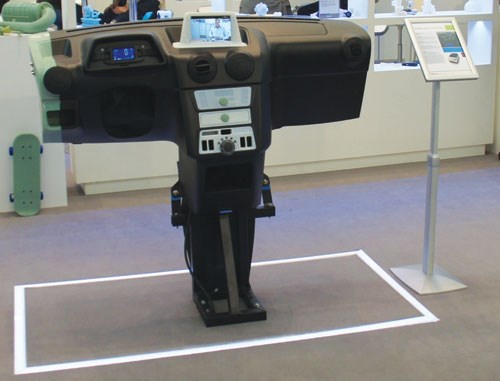3D Printing Providers are Developing Functional and Attractive Materials
When you think “rapid prototyping” via 3D printing you might think of models that aren’t particularly robust, models that are more show than go. But materials and equipment providers are developing materials that are functional as well as attractive.
The Right Material for the Rapid Prototyping Job

When you think “rapid prototyping” via 3D printing you might think of models that aren’t particularly robust, models that are more show than go. But materials and equipment providers are developing materials that are functional as well as attractive. RP materials come in a variety of options from plastics to metals, and they are capable of simulating properties ranging from rubber to tough ABS grade plastics to transparent materials. With the use of these materials, designers and engineers can manufacture detailed parts and models more quickly and cost effectively. According to Oleg Yermanok, corporate applications engineer for Massachusetts-based Objet Inc. (objet.com), the company’s newest materials tout better stiffness and higher-temperature resistance. Here’s a little bit more about what the most recently released materials (the company offers more than 60 total) have to offer:
ABS-Like Digital Material (DM)
RGD5160-DM is a flexible material designed to simulate ABS-grade engineering plastics by combining hightemperature resistance and toughness. This material is best suited for simulated parts that require snap-fit applications, high-impact resistance (1.22-1.5 ft. lb/in.), or shock-absorption. It offers dimension stability, stiffness, and a heat deflection temperature (HDT) of 58-68º C upon removal from the printer. A higher HDT of 82-95º C can be achieved after thermal post-treatment in a programmable oven using different temperature profiles. High Temperature (HT) RGD525 offers thermal functionality with dimensional stability. The material is very stiff and can simulate the thermal performance of engineering plastics. Yermanok adds that it is ideal for thermal testing of static parts like heating and cooling vent covers. It has an HDT of 63–67º C upon removal from the printer and a temperature resistance of up to 80º C.
VeroClear
This rigid and transparent material is suitable for all types of lights and dashboard elements that require a nearly colorless appearance. It features dimensional stability for general purpose, fine detail model building, and visual simulation of a transparent thermoplastic.
Rubber-Like
The company has an entire line of materials in the Tango family, and Yermanok says the TangoBlackPlus is the most popular choice for automotive applications. The line offers various levels of elastomer characteristics including Shore scale A hardness, elongation at break, tear resistance, and tensile strength—making it the best choice for applications requiring non-slip or soft surfaces. While Objet offers multiple printers, it is worth noting that these materials can only be used with the Connex line of 3D printers, the largest of which (the Connex500) is a multi-material jetting technology printer featuring a 500 x 400 x 200-mm build tray. It can print up to 14 different materials in a single print job.
___________________________________________________________________
Sounds Like an Infomercial, But. . .

Brooklyn, NY-based MakerBot (makerbot.com), the company that brought you the Thing-O-Matic 3D personal printer, has launched a new model, the “Replicator,” which has an MSRP of just $1,749. Admittedly, this is a printer that produces models that are somewhat less refined than those produced by higher-end machines. Let’s face it: With budgets being what budgets are, sometimes a quick model that lacks some fidelity will do the trick.
The printer—which measures 320 x 467 x 381 mm—comes with a built-in interface, LCD panel, and control pad that allow users to view build statistics and information as well as control the machine without the use of a computer. An SD card slot allows for the direct loading of models—take a 3D model from your computer, upload it onto the card, put the card in the printer, and let the fabricating begin.
What you should know:
• The Replicator has a build area that’s about the size of a loaf of bread. This means it can print larger objects (up to 8.9 x 5.7 x 5.9 inches in size).
• The printer uses spools of acrylonitrile butadiene styrene (ABS) plastic that come in a variety of colors. Each one costs between $43 and $55 per kilogram, and provides enough material to print the equivalent of 176 chess pieces. The machine can also print with poly lactic acid (PLA), a biomaterial made from corn.
• You can choose layers of thickness between 0.2 and 0.3 mm with the 0.4-mm diameter stock nozzle.
• At a speed of 40 mm/s, the flow rate is approximately 24 cc/hour.
• The printer has a positioning precision of 2.5 micron on the Z axis, and 11 micron on the X and Y axes.
• There is a two-color, multimaterial option ($250).
• It does not slice, dice or rice.
RELATED CONTENT
-
How Real Is Additive Manufacturing?
There is a lot of discussion about how 3D printing/rapid prototyping/additive manufacturing is revolutionizing manufacturing, including automotive manufacturing.
-
Ford Simulates Gravity
Although virtual development tools are being used more and more, there are still some things that are done in the real world.
-
On The Jeep Grand Cherokee, 2022 Nissan Pathfinder, and More
An inside look at the Detroit Assembly Complex-Mack; a innovative approach to waste-free, two-tone painting; why a forging press is like an F1 car; and other automotive developments.









